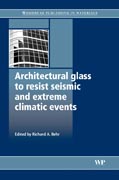
Considers the state of the art in glass and glazing technology to resist failure due to extreme climatic events - reviews specific building techniques andtest methods to enhance glazing performance during snow storms, wind storms and earthquakes Glass is a popular cladding material for modern buildings. The trend for steel-framed, glass-clad buildings instead of those using traditional materials such as brick and concrete has inherent problems. These include, for example, the performance of architectural glass in extreme climatic events such as windstorms and heavy snow loads and also during earthquakes. This bookreviews the state-of-the-art in glass and glazing technology to resist failure due to these natural events. Building code seismic requirements for architectural glass in the United States are considered first of all, followed by a chapter on glazing and curtain wall systems to resist earthquakes. The next two chapters discuss snow loads on building envelopes and glazing systems, and types and design of glazing systems to resist snow loads. Wind pressures and the impact of wind-borne debris are then considered in the next group of chapters which also review special types of glazing systems to resist windstorms. A final chapter reviews test methods for the performance of glazing systems during earthquakes and extreme climatic events. With its distinguished editor and team of contributors, Architectural glass to resist seismic and extreme climatic events is an essential resource for architects, structural, civil and architectural engineers, researchers and those involved in designing and specifyingbuilding glazing and cladding materials in areas where severe windstorms, snow and earthquakes are a threat. INDICE: Building code seismic requirements for architectural glass: the United States R Bachman, R E Bachman Consulting Structural Engineers and S M Dowty, Ghosh Associates, USA - Introduction - Background - Current building code seismic requirements - 2006 IBC/ASCE 7-05 Seismic requirements for nonstructural components - Seismic requirements for architectural glass - Future trends - Sources of further information and advice - References Glazing and curtain wall systems to resist earthquakes A M Memari, The Pennsylvania State University and T A Schwartz, Simpson, Gumpertz and Heger, USA - Introduction -Types of glazing and curtain wall systems - Performance of glazing and curtain wall systems in past earthquakes - Review of laboratory experimental studies - Review of analytical studies - Mitigation of seismic damage to glazing systems - Future trends and conclusions - References Snow loads on building envelopes and glazing systems R Flood, Matrix IMA, USA - Introduction - Snowload sources - Roof snow load per ASCE 7 - 05# - Other roof snow glazing issues - Vertical glazing snow issues - Conclusions - References Architectural glass to resist snow loads R H Davies and N Vigener, P E Simpson, Gumpertz and Heger Inc, USA - Introduction - Sloped glazing system design strategy forsnow and ice - Structural codes and standards - Glass specification per United States standard practice - E1300 Standard practice examples - Discussion - Examples employing methods beyond standard practice - Conclusions - References Wind pressures on building envelopes K Mehta, Texas Tech University, USA - Introduction - Evolution of ASCE 7-05 - Standard of practice for wind pressures - Basic wind speed - Effective velocity pressure, q - Design pressure for components and cladding, p - Example for cladding pressures(r1) - References Architectural glass to resist wind pressures C Barry, Pilkington NA Inc, USA - Glass strength - Stress analysis - Glass types - Deflection - Design procedure - Post-breakage behaviour - Conclusions - References Architectural glass to resist wind-borne debris impacts D B Hattis, Building Technology Inc, USA - Introduction - History of wind-borne debris standards development and regulation - Survey of current design solutions - References Glazing systems to resist windstorms on special buildings J E Minor, Rockport, USA - Introduction - Buildings of special importance or with special functions -Wind analysis - Risk level - Site survey - Site specific design requirements - Design examples - Conclusions - References Test methods for performance of glazing systems and exterior walls during earthquakes and extreme climatic events S A Warner, Architectural Testing Inc, USA - Introduction - The purpose of testing exterior wall mock-ups - The exterior wall test specimen - The testing sequence - Air leakage (ASTM E283) - Tests for water penetration using static pressure (ASTM E331) - Tests for water penetration using dynamicpressure (AAMA 501.1) - Static tests for seismic induced building movement (AAMA 501.4) - Test for differential movement due to thermal expansion and contraction (AAMA 501.5) - Tests for structural performance (ASTM E330) - Dynamic seismic tests (AAMA 501.6) - Evaluation of mock-up test results - Meetingthe building code - The product/systems approval and certification process - Accredited testing laboratories - References
- ISBN: 978-1-84569-369-5
- Editorial: Woodhead
- Encuadernacion: Cartoné
- Páginas: 272
- Fecha Publicación: 01/09/2009
- Nº Volúmenes: 1
- Idioma: Inglés
